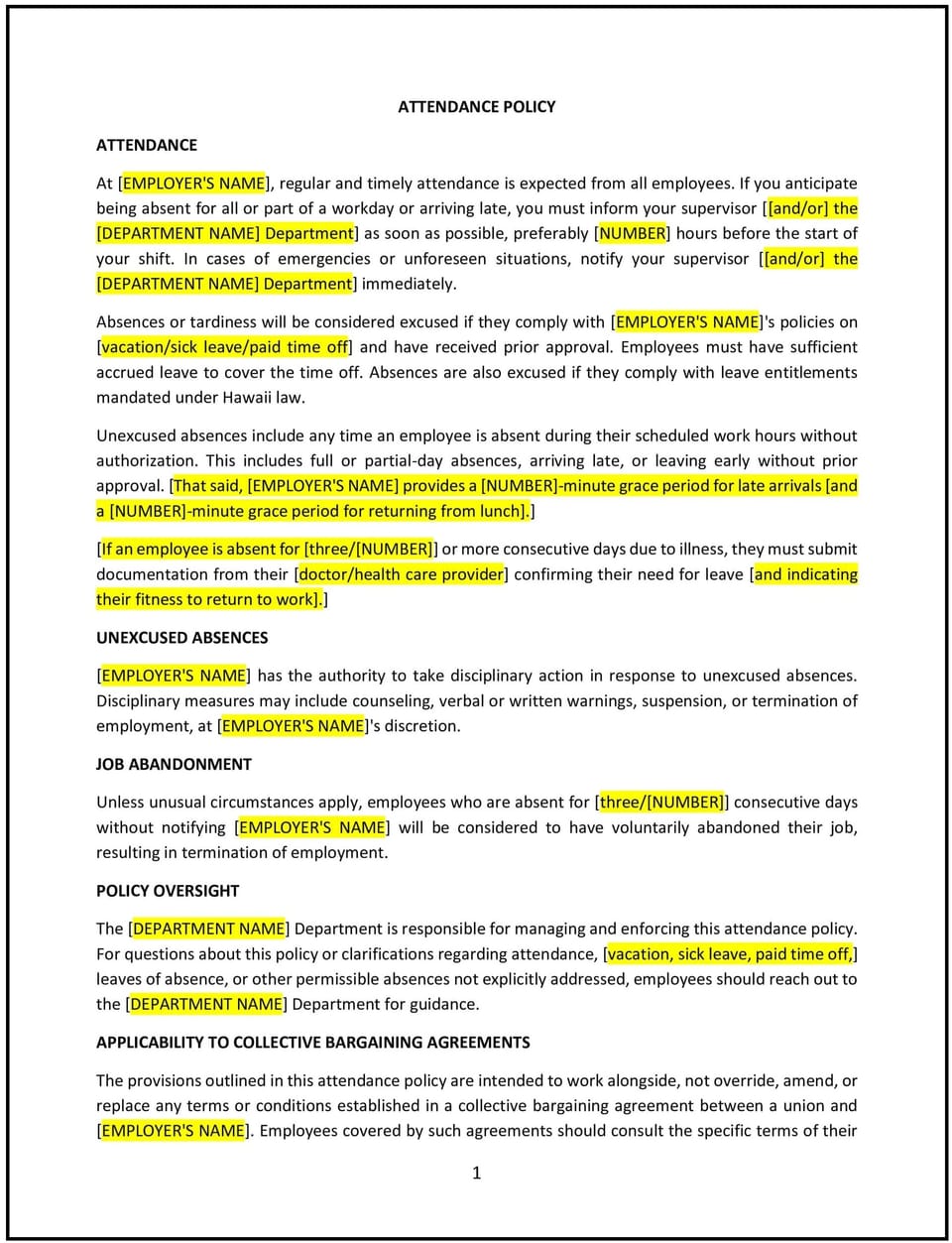Attendance policy (Hawai'i): Free template

Attendance policy (Hawaiʻi)
An attendance policy helps Hawaiʻi businesses establish clear expectations for employee punctuality, attendance, and time-off requests. This policy outlines procedures for reporting absences, managing tardiness, and requesting leave, while considering Hawaiʻi-specific labor laws and workplace dynamics. It is designed to promote consistency, fairness, and productivity in the workplace.
By implementing this policy, businesses in Hawaiʻi can reduce disruptions, maintain operational efficiency, and create a structured environment that supports both employee needs and business goals.
How to use this attendance policy (Hawaiʻi)
- Define attendance expectations: Clearly outline work hours, break times, and expectations for punctuality. Include guidelines for remote or hybrid work arrangements, if applicable.
- Establish procedures for reporting absences: Specify how employees should notify supervisors of absences, including deadlines for reporting and acceptable methods of communication.
- Address tardiness: Provide guidelines for managing late arrivals, including consequences for repeated tardiness and procedures for documenting incidents.
- Outline leave policies: Include details on paid time off (PTO), sick leave, and other types of leave, such as family or medical leave, in alignment with Hawaiʻi state laws.
- Create a system for tracking attendance: Businesses should implement tools or processes to monitor attendance, such as timekeeping software or manual logs, while ensuring accuracy and fairness.
- Communicate consequences: Specify the disciplinary actions that may result from excessive absences or tardiness, ranging from verbal warnings to termination, depending on the severity of the issue.
- Review and update the policy: Regularly assess the policy’s effectiveness and make adjustments as needed to reflect changes in Hawaiʻi laws, workplace dynamics, or business needs.
Benefits of using this attendance policy (Hawaiʻi)
This policy offers several advantages for Hawaiʻi businesses:
- Improves productivity: Clear attendance expectations help minimize disruptions and maintain workflow efficiency.
- Promotes fairness: A consistent policy ensures all employees are treated equally, reducing potential conflicts or misunderstandings.
- Supports compliance: The policy helps businesses align with Hawaiʻi labor laws, such as sick leave requirements under the Hawaiʻi Paid Sick Leave Law.
- Enhances accountability: Employees are more likely to adhere to attendance guidelines when expectations are clearly communicated.
- Reduces administrative burden: A structured policy simplifies the process of managing attendance records and addressing issues.
- Encourages transparency: Employees understand their rights and responsibilities regarding attendance, fostering trust and clarity in the workplace.
Tips for using this attendance policy (Hawaiʻi)
- Communicate the policy effectively: Share the policy with all employees during onboarding and through regular reminders, such as emails or posters in common areas.
- Provide training: Businesses should educate employees on the policy’s guidelines, including how to report absences and request leave.
- Be flexible when possible: Consider individual circumstances, such as medical conditions or family emergencies, when enforcing the policy.
- Monitor attendance consistently: Use reliable tools or systems to track attendance and address issues promptly.
- Lead by example: Ensure leadership adheres to the policy and models punctuality and accountability.
- Review the policy periodically: Update the policy as needed to reflect changes in Hawaiʻi laws, workplace dynamics, or business needs.
Q: Why should Hawaiʻi businesses adopt an attendance policy?
A: Businesses should adopt this policy to establish clear expectations, improve productivity, and ensure fairness in managing employee attendance.
Q: What should be included in an attendance policy?
A: The policy should include work hours, procedures for reporting absences, guidelines for managing tardiness, and details on leave policies, such as sick leave or PTO.
Q: How should businesses handle excessive absences?
A: Businesses should address excessive absences through a structured process, such as verbal warnings, written notices, or disciplinary action, depending on the severity of the issue.
Q: What tools can businesses use to track attendance?
A: Businesses can use timekeeping software, manual logs, or other systems to monitor attendance accurately and fairly.
Q: How should businesses handle leave requests?
A: Businesses should establish clear procedures for requesting leave, including deadlines and required documentation, while considering Hawaiʻi state laws.
Q: What should businesses do if an employee is consistently late?
A: Businesses should address repeated tardiness through a progressive disciplinary process, starting with verbal warnings and escalating to written notices or other actions if necessary.
Q: How often should the policy be reviewed?
A: The policy should be reviewed annually or as needed to reflect changes in Hawaiʻi laws, workplace dynamics, or business needs.
This article contains general legal information and does not contain legal advice. Cobrief is not a law firm or a substitute for an attorney or law firm. The law is complex and changes often. For legal advice, please ask a lawyer.


